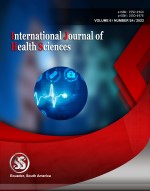Comparison of flexural strength in two types of denture base resins
Keywords:
Denture, Base, ResinAbstract
Background: The present study was conducted for assessing and comparing flexural strength in two types of denture base resins. Materials & methods: A total of 20 acrylic specimens were made. Stainless steel dies were made. Twenty acrylic specimens were fabricated using these stainless steel dies. The metal dies were flasked using dental plaster to complete the flasking procedure. The stainless steel dies were retrieved to create the mold space for the acrylic specimen. All the specimens were randomly divided into to study groups as follows: Group A: Conventional denture base resins and Group B: Glass reinforced denture base resins. Flexural strength of the samples was accessed using the universal testing machine. Results: Mean flexural strength of group A specimens was 109.5 MPa. Mean flexural strength of group B specimens was 139.7 MPa. While comparing the mean flexural strength between group A and group B, significant results were obtained. Conclusion: Glass reinforced denture base resins demonstrated higher flexural strength in comparison to conventional denture base resin.
Downloads
References
Arima T, Murata H, Hamada T. Properties of highly cross-linked autopolymerizing reline acrylic resins. J Prosthet Dent. 1995;73:55–9.
Uzun G, Hersek N, Tinçer T. Effect of five woven fiber reinforcements on the impact and transverse strength of a denture base resin. J Prosthet Dent. 1999;81:616–20.
Franklin P, Wood DJ, Bubb NL. Reinforcement of poly (methyl methacrylate) denture base with glass flake. Dent Mater. 2005;21:365–70.
Grajower R, Goultschin J. The transverse strength of acrylic resin strips and of repaired acrylic samples. J Oral Rehabil. 1984;11:237–47.
Jagger RG. Effect of the curing cycle on some properties of a polymethylmethacrylate denture base material. J Oral Rehabil. 1978;5:151–7.
Harrison A, Huggett R. Effect of the curing cycle on residual monomer levels of acrylic resin denture base polymers. J Dent. 1992;20:370–4.
Reis JM, Vergani CE, Pavarina AC, Giampaolo ET, Machado AL. Effect of relining, water storage and cyclic loading on the flexural strength of a denture base acrylic resin. J Dent. 2006;34:420–6.
Barbosa DB, de Souza RF, Pero AC, Marra J, Compagnoni MA. Flexural strength of acrylic resins polymerized by different cycles. J Appl Oral Sci. 2007;15:424–8.
Stipho HD. Effect of glass fiber reinforcement on some mechanical properties of autopolymerizing polymethyl methacrylate. J Prosthet Dent. 1998;79:580–4.
Stipho HD. Repair of acrylic resin denture base reinforced with glass fiber. J Prosthet Dent. 1998;80:546–50.
Chanana, M. (2018). Empirical study: relationship between self efficacy and academic performance. International Journal of Health & Medical Sciences, 1(1), 28-34. https://doi.org/10.31295/ijhms.v1n1.36
Jaikumar RA, Karthigeyan S, Ali SA, Naidu NM, Kumar RP, Vijayalakshmi K. Comparison of flexural strength in three types of denture base resins: An in vitro study. J Pharm Bioallied Sci. 2015;7(Suppl 2):S461-S464.
Nyandra, M., Suryasa, W. (2018). Holistic approach to help sexual dysfunction. Eurasian Journal of Analytical Chemistry, 13(3), pp. 207–212.
Choksi RH, Mody PV. Flexural properties and impact strength of denture base resins reinforced with micronized glass flakes. J Indian Prosthodont Soc. 2016;16(3):264-270.
Published
How to Cite
Issue
Section
Copyright (c) 2022 International journal of health sciences

This work is licensed under a Creative Commons Attribution-NonCommercial-NoDerivatives 4.0 International License.
Articles published in the International Journal of Health Sciences (IJHS) are available under Creative Commons Attribution Non-Commercial No Derivatives Licence (CC BY-NC-ND 4.0). Authors retain copyright in their work and grant IJHS right of first publication under CC BY-NC-ND 4.0. Users have the right to read, download, copy, distribute, print, search, or link to the full texts of articles in this journal, and to use them for any other lawful purpose.
Articles published in IJHS can be copied, communicated and shared in their published form for non-commercial purposes provided full attribution is given to the author and the journal. Authors are able to enter into separate, additional contractual arrangements for the non-exclusive distribution of the journal's published version of the work (e.g., post it to an institutional repository or publish it in a book), with an acknowledgment of its initial publication in this journal.
This copyright notice applies to articles published in IJHS volumes 4 onwards. Please read about the copyright notices for previous volumes under Journal History.
















